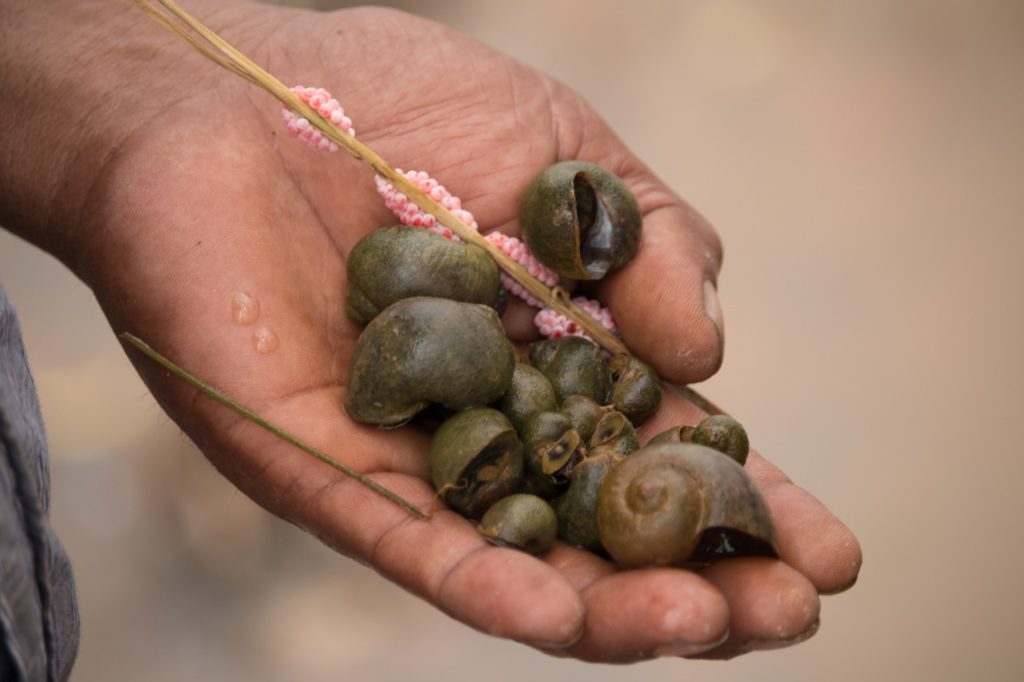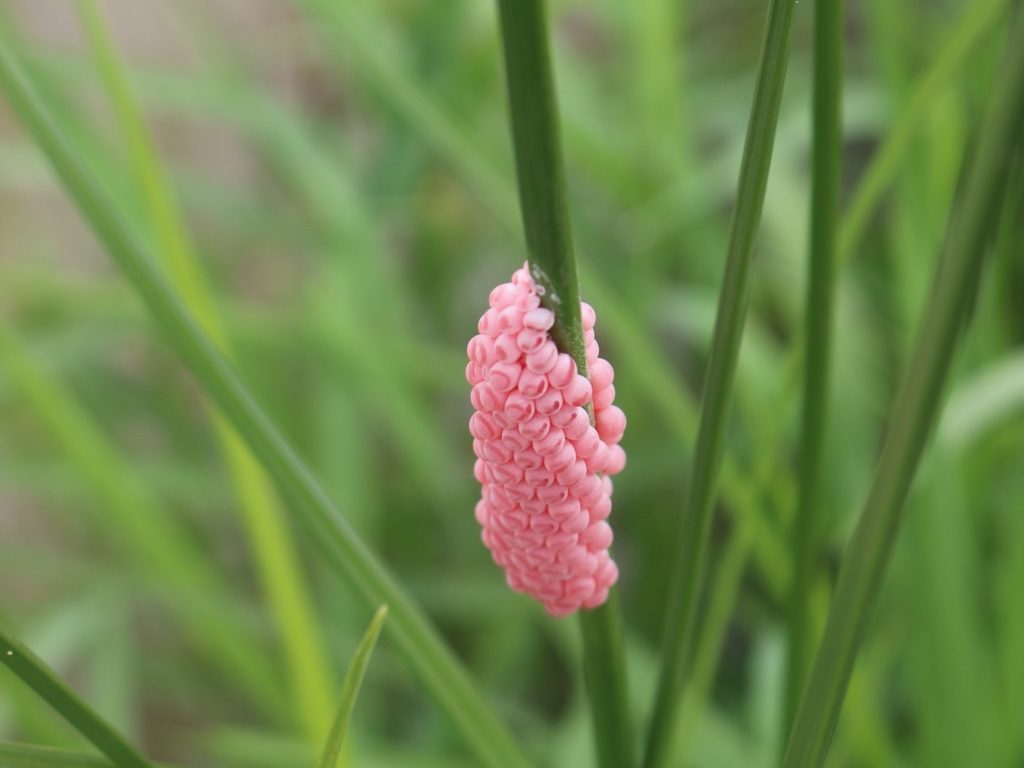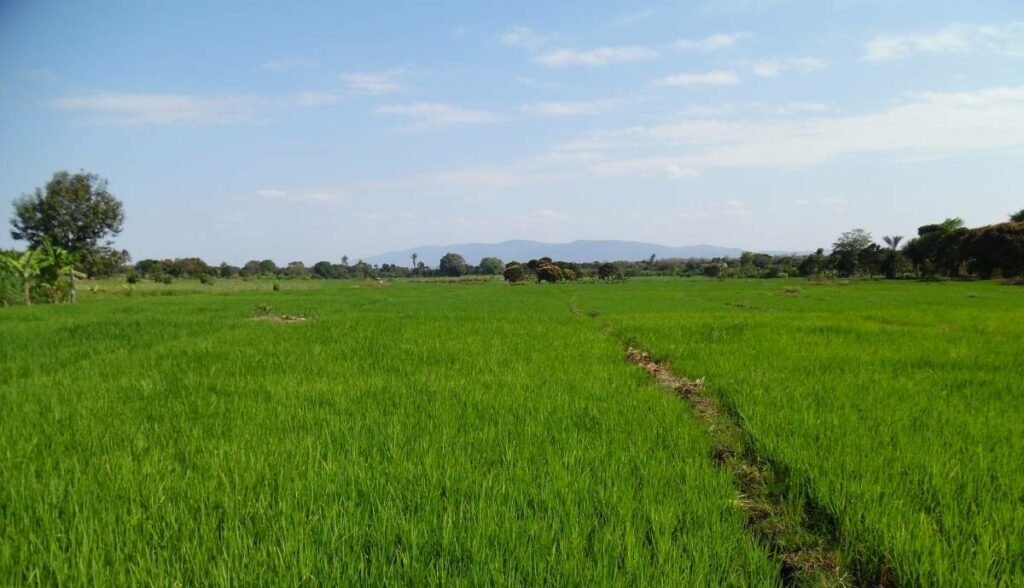Earlier this year, scientists from CABI and the Kenya Plant Health Inspectorate Service (KEPHIS) published new research confirming that the apple snail, Pomacea canaliculata, had been discovered in Kenya for the first time. Widely considered to be one of the most invasive invertebrates of waterways and irrigation systems, the apple snail threatens Kenya’s rice production and raises the question, how much damage will it cause in Kenya and beyond?

In May this year, CABI published a working paper to provide a review of the global invasive spread of P. canaliculata, its biology and ecological adaptability and assesses the risks and potential economic and yield losses for East and sub-Saharan African rice production over the next decade under different control scenarios. In this blog, we look at the threat and potential economic impacts of invasive apple snail in East Africa, and options and recommendations for its management.
The invasive apple snail threat
Invasive apple snails grow and reproduce quickly and can rapidly adapt to their conditions. They feed voraciously in the absence of their preferred plants. Staple crops such as taro and rice, as well as other aquatic cultivated crops, suffer heavily from their destructive feeding, with young rice seedlings representing the most vulnerable stage. Entire fields can be lost, affecting smallholder farmer livelihoods.
Aside from the potential damage to farmer incomes and food security, invasive apple snails also negatively impact wetland ecosystems and human health as they are vectors for parasites, such as rat lungworm, and can cause skin irritations. Other economic impacts occur indirectly through payment for pesticides and labour costs for physical removal of the snails in addition to environmental risks associated with over- or improper use of chemical control options in these systems.
Climate modelling indicates that many of the rice-producing areas of eastern Africa, and sub-Saharan Africa more broadly, are likely to come under threat from the apple snail, including all areas of Tanzania, the major rice producer in the region. Climate change will undoubtedly contribute to wider establishment and potential ‘hot spots’ for higher population density.

Potential economic impacts of invasive apple snail in East Africa
Invasive apple snails damage most aquatic crops, but it is their impact on rice crops for which they have gained notoriety around the world. Examples from Asia indicate that once present, P. canaliculata can spread rapidly; entry into waterways and irrigation systems results in widespread infestation of rice paddies.
Mwea is the primary rice-growing area in Kenya and in this region alone, P. canaliculata has the potential to affect approximately 80% of Kenya’s rice production. Present and near-term losses are likely to be important, as P. canaliculata has a foothold and is already affecting production, but without efforts to manage populations and contain the snail’s spread, future losses across the region to rice and other host crops could be much greater.
Extensive documented evidence suggests that its capacity for damage to invaded wetland agricultural systems should not be underestimated, with annual global agricultural economic losses stated as ranging from US$55 to US$248 billion/year. In the Philippines alone, estimates of cumulative economic losses associated with P. canaliculata ranged from US$425 million to US$1.18 billion by the mid-1990s (US$860 million to US$2.39 billion in 2021 values since its first introduction in the early 1980s).
Were P. canalicula to spread across the region to infest rice in parts of Tanzania, Uganda and Ethiopia in addition to Kenya, annual production losses of US$122 million could be feasible within a decade of arrival without control measures. The paper states that even with control measures, regional losses of US$67-116 million each year could be possible if the snail is not contained.
What action can we take?
Given the strategic importance of rice to the food and nutrition security and income generation of the region, it is imperative that ecologically and economically sustainable approaches are put into practice for the integrated control of this destructive invasive mollusc in Kenya. The implementation of effective quarantine and contingency measures can help avoid further spread of the apple snail to vulnerable areas of the country and neighbouring rice-growing countries.

In the absence of effective containment and sustainable management options, spread to other rice-growing regions of Kenya and neighbouring countries is highly likely. Going forward, stakeholders will need to take action, including policy and regulatory measures and further research such as impact surveys. Information must be shared through advisory services with farmers to foster effective sustainable management practices. Further research should also include testing locally adaptable lower risk methods for the management of the mollusc. It will be important to raise awareness among rice growers in the affected areas about this species, as well as those in the currently unaffected areas including what they can do to avert invasion and further spread.
For countries which are free of snails, identifying potential introduction pathways (e.g., transfer of seedlings, sharing of farm machinery and equipment between schemes etc.), developing risk assessments, implementing a clean certification scheme for traded plants from contaminated areas and elaborating rapid response plans for new incursions will be important to help mitigate impact.
See the full working paper here: The apple snail, Pomacea canaliculata: an evidence note on invasiveness and potential economic impacts for East Africa
See the Apple Snail Information Portal here
For more information about CAB’s work in invasive species, go to www.cabi.org/what-we-do/invasive-species
Further reading
Related News & Blogs
What makes invasive apple snail the worst invasive invertebrate of waterways?
This article was originally published on CABI Digital Library Overview: What is the invasive apple snail? The invasive apple snail is a large freshwater snail with a large variation in shell colour. This species is in the ‘top 100 worst invasive specie…
10 April 2024



